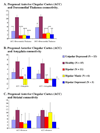Resting state corticolimbic connectivity abnormalities in unmedicated bipolar disorder and unipolar depression
- PMID: 19230623
- PMCID: PMC3001251
- DOI: 10.1016/j.pscychresns.2008.03.012
Resting state corticolimbic connectivity abnormalities in unmedicated bipolar disorder and unipolar depression
Abstract
This study for the first time investigated resting state corticolimbic connectivity abnormalities in unmedicated bipolar disorder (BD) and compared them with findings in healthy controls and unipolar major depressive disorder (MDD) patient groups. Resting state correlations of low frequency BOLD fluctuations (LFBF) in echoplanar functional magnetic resonance (fMRI) data were acquired from a priori defined regions of interests (ROIs) in the pregenual anterior cingulate cortex (pgACC), dorsomedial thalamus (DMTHAL), pallidostriatum (PST) and amygdala (AMYG), to investigate corticolimbic functional connectivity in unmedicated BD patients in comparison to healthy subjects and MDD patients. Data were acquired from 11 unmedicated BD patients [six manic (BDM) and five depressed (BDD)], and compared with data available from 15 unmedicated MDD and 15 healthy subjects. BD patients had significantly decreased pgACC connectivity to the left and right DMTHAL, similar to findings seen in MDD. Additionally, BD patients had decreased pgACC connectivity with the left and right AMYG as well as the left PST. An exploratory analysis revealed that both BDD and BDM patients had decreased connectivity between the pgACC and DMTHAL. The results of the study indicate a common finding of decreased corticolimbic functional connectivity in different types of mood disorders.
Figures


References
-
- Adler CM, DelBello MP, Strakowski SM. Brain network dysfunction in bipolar disorder. CNS Spectrums. 2006;11:312–320. - PubMed
-
- Altshuler L, Bookheimer S, Proenza MA, Townsend J, Sabb F, Firestine A, Bartzokis G, Mintz J, Mazziotta J, Cohen MS. Increased amygdala activation during mania: a functional magnetic resonance imaging study. American Journal of Psychiatry. 2005;162:1211–1213. - PubMed
-
- Anand A, Charney DS. Abnormalities in catecholamines and pathophysiology of bipolar disorder. In: Soares JC, Gershon S, editors. Bipolar Disorder: Basic Mechanisms and Therapeutic Implications. New York: Marcel Dekker; 2000. pp. 59–94.
-
- Anand A, Li Y, Wang Y, Wu J, Gao S, Kalnin A, Mathews VP, Lowe MJ. Activity and connectivity of mood regulating circuit in depression: a functional magnetic resonance study. Biological Psychiatry. 2005a;15:1079–1088. - PubMed
-
- Anand A, Li Y, Wang Y, Wu JW, Gao SJ, Bukhari L, Mathews VP, Kalnin A, Lowe MJ. Antidepressant effect on connectivity of the mood-regulating circuit: an fMRI study. Neuropsychopharmacology. 2005b;30:1334–1344. - PubMed

